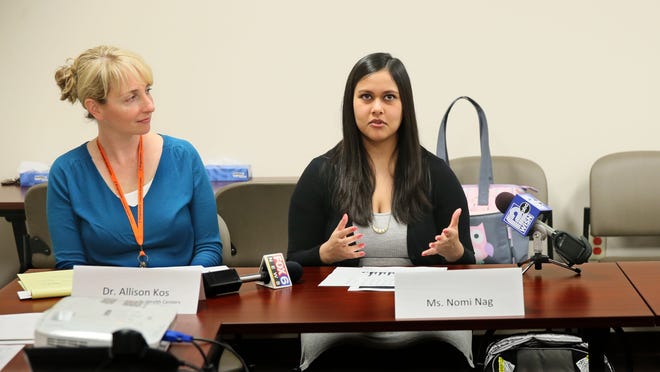50 times stronger than heroin, fentanyl now 'the real killer'

From the Milwaukee County Medical Examiner’s Office to community health centers, an unabated opioid crisis continues to overwhelm the county’s public health infrastructure, several drug experts said Monday.
Much of the problem over the last year is tied to the narcotic fentanyl, which can be more than 50 times as powerful as heroin, and has flooded into the community.

New forms of the drug, which often comes from Mexico and China, continue be developed illegally.
Last year, 97 drug overdose deaths in the county involved fentanyl, compared with just 16 in 2011, said Milwaukee County Medical Examiner Brian Peterson.
“The numbers keep getting scarier,” he said. “Heroin is still a big player. The real killer is fentanyl.”
Peterson spoke at a meeting hosted by U.S. Sen. Tammy Baldwin (D-Wis.) at the Lisbon Avenue Health Center in Milwaukee.
Baldwin said she has hosted similar sessions around the state.
“In many ways it is the same everywhere,” she said. “It is frightening. We are all waiting to see signs we’ve turned the corner.”
Baldwin noted that a provision she co-sponsored in the 21st Century Cures Act calls for spending $1 billion on drug treatment and prevention. That money will be given out in grants to communities.
She also said that a provision in the Affordable Care Act to provide insurance for addiction treatment needs to be protected.
Peterson said at least four new analogs of fentanyl have hit the streets and all of them are extremely powerful.
The drug Narcan (naloxone), which can be given as an antidote, can be overwhelmed by the strength of the new forms of fentanyl, he said.
He said if he had the resources, he would update his toxicology lab so that new forms of a drug could be detected much quicker, in a less than a day. That would allow the office to notify police what was appearing in certain neighborhoods.
While some states such as Ohio can identify a drug in a day, toxicology testing can take weeks in Milwaukee County.
“The better we can be, the more we can help survivors,” Peterson said.
Another big problem is long waiting lists for addicts seeking to enter rehab, several speakers said.
Kristen Wlodek, a clinical coordinator at Outreach Community Health, said clients often have to wait eight months before they can get into a treatment program.
Hiring health care personnel who can prescribe drugs used to treat addiction has been a problem as well, said Allison Kos, a physician and chief medical officer at Progressive Community Health Centers.
“There is a lot of turnover,” she said. “It is a high burnout situation.”
Ald. Michael Murphy said the problem has spread around the county. The typical overdose victim now is a 44-year-old white male, he said.
While public officials have been raising awareness in schools, more needs to be done to reach middle-aged users, he said.
Past drug spikes such as the crack epidemic were treated largely as a law enforcement problem rather than a public health crisis, he said.
“You are not going to arrest your way out of this problem,” he said.
RELATED: 50 times stronger than heroin, fentanyl now 'the real killer'